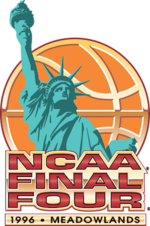 | |||||
| Season | 1995–96 | ||||
|---|---|---|---|---|---|
| Teams | 64 | ||||
| Finals site | Continental Airlines Arena East Rutherford, New Jersey | ||||
| Champions | Kentucky Wildcats (6th title, 8th title game, 11th Final Four) | ||||
| Runner-up | Syracuse Orangemen (2nd title game, 3rd Final Four) | ||||
| Semifinalists |
| ||||
| Winning coach | Rick Pitino (1st title) | ||||
| MOP | Tony Delk (Kentucky) | ||||
| Attendance | 631,834 | ||||
| Top scorer | John Wallace (Syracuse) (29 points) | ||||
| |||||
The 1996 NCAA Division I men's basketball tournament involved 64 schools playing in single-elimination play to determine the national champion of men's NCAA Division I college basketball. It began on March 14, 1996, and ended with the championship game on April 1 at Continental Airlines Arena (now known as Meadowlands Arena) in the Meadowlands Sports Complex in East Rutherford, New Jersey. A total of 63 games were played.
The Final Four venue was notable for several reasons:
- This marked the first time that the NCAA finals had been held in Greater New York since 1950.
- This was also the last (men's) Final Four to be held in a basketball/hockey-specific facility. Every Final Four since has been held in a domed stadium (usually built for football) because of NCAA venue capacity requirements. Therefore, this was also the last time the NCAA finals have been held in the Greater New York area and the Northeastern United States (for the time being).
The Final Four consisted of Kentucky, making its first appearance in the Final Four since 1993 and eleventh overall, Massachusetts, making its first ever appearance in the Final Four, Syracuse, making its third appearance in the Final Four and first since 1987, and Mississippi State, also making its first appearance.
Kentucky won its sixth national championship by defeating Syracuse in the final game 76–67.
Tony Delk of Kentucky was named the tournament's Most Outstanding Player. Kentucky's run to the championship was one of the most dominant in NCAA tournament history, as the Wildcats won each of their first four games by at least 20 points and won every game by at least 7 points.
Massachusetts, coached by John Calipari, was later stripped of its wins, including the UMass Minutemen's Final Four appearance, by the NCAA because UMass star Marcus Camby had accepted illegal gifts from agents. Connecticut, coached by Jim Calhoun, was additionally punished monetarily due to players accepting illegal gifts from agents.[1]
The 1996 tournament was the last to feature teams from the Big Eight and Southwest Conferences; later that year the two would form the Big 12 Conference. As of 2022 they are the last Division I conferences to disband and/or merge after sending teams to the NCAA tournament.
- ^ Cavanaugh, Jack (May 9, 1997). "UMass and UConn Lose '96 Honors". The New York Times.